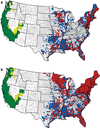County-Scale Distribution of Ixodes scapularis and Ixodes pacificus (Acari: Ixodidae) in the Continental United States
- PMID: 26783367
- PMCID: PMC4844559
- DOI: 10.1093/jme/tjv237
County-Scale Distribution of Ixodes scapularis and Ixodes pacificus (Acari: Ixodidae) in the Continental United States
Abstract
The blacklegged tick, Ixodes scapularis Say, is the primary vector to humans in the eastern United States of the Lyme disease spirochete Borrelia burgdorferi, as well as causative agents of anaplasmosis and babesiosis. Its close relative in the far western United States, the western blacklegged tick Ixodes pacificus Cooley and Kohls, is the primary vector to humans in that region of the Lyme disease and anaplasmosis agents. Since 1991, when standardized surveillance and reporting began, Lyme disease case counts have increased steadily in number and in geographical distribution in the eastern United States. Similar trends have been observed for anaplasmosis and babesiosis. To better understand the changing landscape of risk of human exposure to disease agents transmitted by I. scapularis and I. pacificus, and to document changes in their recorded distribution over the past two decades, we updated the distribution of these species from a map published in 1998. The presence of I. scapularis has now been documented from 1,420 (45.7%) of the 3,110 continental United States counties, as compared with 111 (3.6%) counties for I. pacificus. Combined, these vectors of B. burgdorferi and other disease agents now have been identified in a total of 1,531 (49.2%) counties spread across 43 states. This marks a 44.7% increase in the number of counties that have recorded the presence of these ticks since the previous map was presented in 1998, when 1,058 counties in 41 states reported the ticks to be present. Notably, the number of counties in which I. scapularis is considered established (six or more individuals or one or more life stages identified in a single year) has more than doubled since the previous national distribution map was published nearly two decades ago. The majority of county status changes occurred in the North-Central and Northeastern states, whereas the distribution in the South remained fairly stable. Two previously distinct foci for I. scapularis in the Northeast and North-Central states appear to be merging in the Ohio River Valley to form a single contiguous focus. Here we document a shifting landscape of risk for human exposure to medically important ticks and point to areas of re-emergence where enhanced vector surveillance and control may be warranted.
Figures


References
-
- Apperson CS, Levine JF, Evans TL, Braswell A, Heller J. Relative utilization of reptiles and rodents by immature Ixodes scapulris (Acari: Ixodidae) in the coastal plain of North Carolina, USA. Exp. Appl. Acarol. 1993;17:719–731. - PubMed
-
- Bacon RM, Kugeler KJ, Mead PS. Surveillance for Lyme disease - United States, 1992–2006. Morbid. Mortal. Wkly. Rep. 2008;57:1–9. - PubMed
-
- Bouseman JK, Kitron U, Kirkpatrick CE, Siegel J, Todd KS. The status of Ixodes dammini (Acari: Ixodidae) in Illinois. J. Med. Entomol. 1990;27:556–560. - PubMed
MeSH terms
Grants and funding
LinkOut - more resources
Full Text Sources
Other Literature Sources
Miscellaneous

